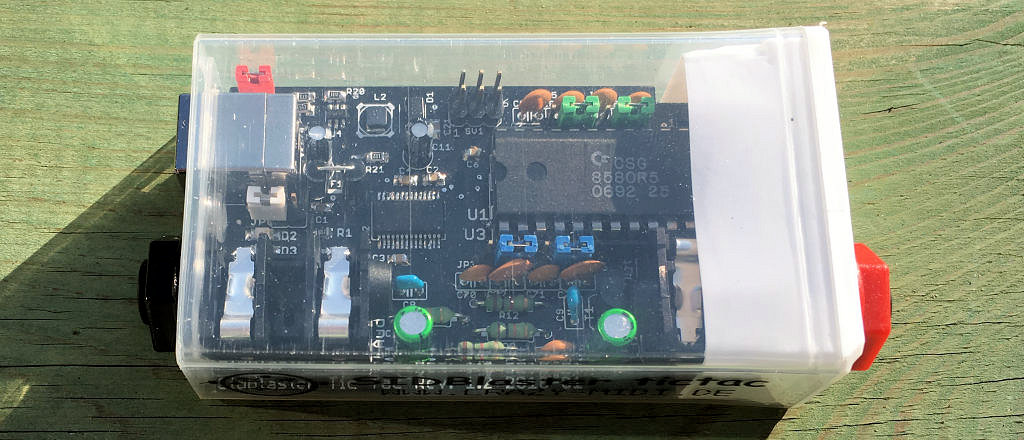After composing a few tunes in GoatTracker and CheeseCutter, both editors that use the reSID emulator in Windows, I thought it might be prudent to test them on the real deal. Stein Pedersen (of Prosonix fame) then recommended the SidBlaster, a small device that can be equipped with a real SID chip.
The device is connected to the USB port of the PC and supports the HardSID DLL standard. This makes it compatible with the classic SidPlay, ACID 64 Player Pro, GoatTracker, VICE, and more.
I got in contact with the creator of the Tic Tac design, Andreas Schumm, on Facebook. He created and sent me the device for 83€ via PayPal. I had mentioned that I intended to use it with an 8580 SID chip and all of its jumpers were already set accordingly when I received it. It was also encapsulated in a Tic Tac box.
Earlier that day, I had also received the 8580 SID chip which I had bought on eBay for 33€. I took the device out of the Tic Tac box and put the chip into the socket. On the GitHub page for the device, there was a document about how to set jumpers, how to connect, and various other practical information.
One of the caveats in that document was that I should avoid using USB hubs as they could be trouble. I first tried connecting the device to a USB port on the front edge side of my PC cabinet, but this didn’t work. I had to use a USB port on the back of the PC before it was detected properly. I guess the front edge line of USB ports is actually regarded as sort of an internal USB hub.
I connected the audio cable to the blue “Line In” port on the back of the PC. In Windows 10, I had to tick a check box named “Listen to this device” in the properties for this port, and I also had to turn the volume up to 100% for it to match the level of any other sound coming from the loudspeakers.
The GitHub page also had the HardSID DLL files for both 32 bit and 64 bit. Although I was using a 64-bit Windows 10, I had to use the 32 bit version for SidPlay and GoatTracker as they were 32 bit programs. The DLL from the GitHub page worked fine for GoatTracker that played my latest SID tune through SidBlaster without any problems, which was a bit ironic as the docs said it wasn’t perfect.
My version of SidPlay, Sidplay2/w win32 v2.6 (Aug 6 2011), didn’t like the DLL, however. Although it could detect the device number, it crashed as I tried to play one of Hubbard’s classics. Andreas Schumm then recommended an older BETA driver on CSDb, and that version of the DLL worked fine in it.
The only problem I had left was the sound only coming from the left loudspeaker. This probably shouldn’t come as a surprise since SID chips are mono by nature, but I had hoped that the audio cable I had bought managed to spread it out into both loudspeakers. But instead of having to go shop for a different cable, I discovered that there’s actually an option in Windows 10 settings that can make it mono.
To do this, just open Settings and enter the Ease of Access section. Click Audio in the left panel. Now find the “Turn on mono audio” option and flick it on. Both loudspeakers should now play SID music. There are also mixers that can do this. For example, check out the VoiceMeeter Banana Advanced Mixer.
So, here’s a nifty check list for new owners of a SidBlaster:
- Don’t use an USB port on the front edge of the PC cabinet. Use one on the back side.
- Remember to tick the “Listen to this device” check box if using the blue “Line In” port.
- If in doubt whether the device works, you can use head phones to test it. I did that at first.
- The USB cable type that works is the one that is typically used for printers.
- As the docs say, leave the flap open and disconnect the USB when not using the device.
- Be careful that the red jumper is set correctly. My guess is that you can blow your chip.
- Download the DLL file from one of the above links and paste it into the folder of a program.
- If you have trouble with programs crashing, try the older BETA version of the DLL instead.
- For GoatTracker, use the
-H01command-line switch to use SidBlaster with it. - For SidPlay, open menu
Settings > Deviceand select the HardSID radio button. - If you only have sound in one loudspeaker, you can turn on mono in Windows settings.
If you’re making music with a DAW that support VST plugins, Andreas made an AIASS Mono VST plugin for use with the SidBlaster. See also this page for downloads.


